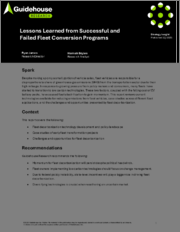
|
시장보고서
상품코드
1759954
플릿 전환 프로그램의 성공과 실패로부터 얻은 교훈Lessons Learned from Successful and Failed Fleet Conversion Programs |
||||||
자동차 판매량의 극히 일부에 불과하지만, 차량은 주행거리가 많기 때문에 운송 부문에서 배출되는 온실가스의 불균형적인 비율을 차지합니다. 정책 입안자와 소비자의 압력이 증가함에 따라 많은 차량이 저탄소 기술로 전환하기 시작했습니다. 이 두 가지 요인은 EV 배터리 팩의 비용 하락과 함께 차량 전동화의 추진력을 높이고 있습니다.
이 보고서에서는 차량에서 배출되는 배기가스를 줄이기 위해 현재 사용 가능한 기술과 차량 탈탄소화에 따른 과제와 기회를 검토합니다. 또한 다양한 차량 적용 사례 연구를 통해 차량 전환의 성공 사례와 실패 사례를 소개합니다. 이 사례 연구들은 차량 탈탄소화에 따른 현실적인 과제와 기회에 대한 귀중한 인사이트를 제공합니다.
이 보고서는 또한 차량 탈탄소화를 위한 혁신적인 솔루션의 필요성을 강조하고 있습니다. 이를 통해 이해관계자들은 비용 절감과 운영 효율성 개선의 혜택을 누리면서 차량이 환경에 미치는 영향을 줄이기 위해 정보에 입각한 결정을 내릴 수 있습니다.
목차
이 리포트에서는 다음 내용을 다룹니다.
- 플릿 탈탄소화 기술 개발과 정책 상황
- 초기 플릿 변혁 프로젝트의 사례 연구
- 차량 탈탄소화의 과제와 기회
Despite making up only a small portion of vehicle sales, fleet vehicles are responsible for a disproportionate share of greenhouse gas emissions from the transportation sector due to their high mileage. In response to growing pressure from policy makers and consumers, many fleets have started to transition to low carbon technologies. These two factors, coupled with the falling cost of EV battery packs, have caused fleet electrification to gain momentum.
This report reviews current technologies available for reducing emissions from fleet vehicles and the challenges and opportunities presented by fleet decarbonization. It includes case studies across different fleet applications, showcasing both successful and failed attempts at fleet conversion. These case studies provide valuable insights into the practical challenges and opportunities presented by fleet decarbonization.
The report also emphasizes the need for innovative solutions in decarbonizing fleets. By focusing on these, stakeholders can make informed decisions that reduce the environmental impact of fleet vehicles while benefiting from cost savings and improved operational efficiency.
Table of Contents
This report covers the following:
- Fleet decarbonization technology development and policy landscape
- Case studies of early fleet transformation projects
- Challenges and opportunities for fleet decarbonization














